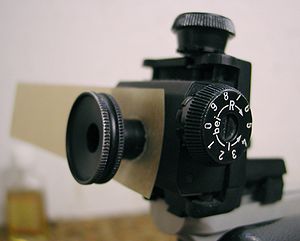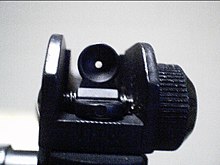
Parallax is a displacement or difference in the apparent position of an object viewed along two different lines of sight and is measured by the angle or half-angle of inclination between those two lines. Due to foreshortening, nearby objects show a larger parallax than farther objects, so parallax can be used to determine distances.
The Colt Canada C7 and C8 are a Canadian family of service rifles, manufactured by Colt Canada, having similar design and function to the Colt M16A3.
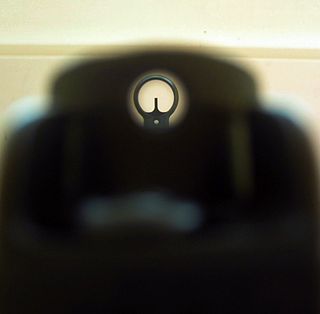
Iron sights are a system of physical alignment markers used as a sighting device to assist the accurate aiming of ranged weapons such as firearms, airguns, crossbows, and bows, or less commonly as a primitive finder sight for optical telescopes. Iron sights, which are typically made of metal, are the earliest and simplest type of sighting device. Since iron sights neither magnify nor illuminate the target, they rely completely on the viewer's naked eye and the available light by which the target is visible. In this respect, iron sights are distinctly different from optical sight designs that employ optical manipulation or active illumination, such as telescopic sights, reflector (reflex) sights, holographic sights, and laser sights.
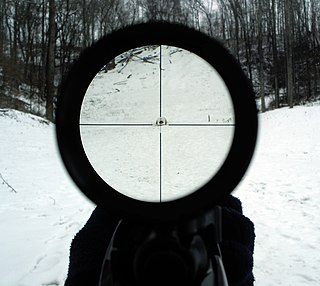
A telescopic sight, commonly called a scope informally, is an optical sighting device based on a refracting telescope. It is equipped with some form of a referencing pattern – known as a reticle – mounted in a focally appropriate position in its optical system to provide an accurate point of aim. Telescopic sights are used with all types of systems that require magnification in addition to reliable visual aiming, as opposed to non-magnifying iron sights, reflector (reflex) sights, holographic sights or laser sights, and are most commonly found on long-barrel firearms, particularly rifles, usually via a scope mount. Similar devices are also found on other platforms such as artillery, tanks and even aircraft. The optical components may be combined with optoelectronics to add night vision or smart device features.

A sight or sighting device is any device used to assist in precise visual alignment of weapons, surveying instruments, aircraft equipment, optical illumination equipment or larger optical instruments with the intended target. Sights can be a simple set or system of physical markers that serve as visual references for directly aligning the user's line of sight with the target, or optical instruments that provide an optically enhanced—often magnified—target image aligned in the same focus with an aiming point. There are also sights that actively project an illuminated point of aim onto the target itself so it can be observed by anyone with a direct view, such as laser sights and infrared illuminators on some night vision devices, as well as augmented or even virtual reality-enabled digital cameras with software algorithms that produce digitally enhanced target images.

Benchrest shooting is a shooting sport discipline in which high-precision rifles are rested on a table or bench – rather than being carried in the shooter's hands – while shooting at paper or steel targets, hence the name "benchrest". Both the forearm and buttstock of such a rifle are usually fully supported by bean bags, a bipod/monopod (front/rear) combination, and/or a specially designed fixture device called shooting rest, so that the gun can remain stably pointing at the target without needing to be held by someone. When shooting, the shooter simply sits/stands comfortably behind the table/bench, operates the action and pulls the trigger, without needing to worry about carrying any weight of the gun. This is in contrast to other shooting disciplines, where the shooter has to bear at least part of the gun's weight while holding it steady to aim, even when using support devices such as bipods, tripods or shooting sticks.

10 meter air rifle is an International Shooting Sports Federation (ISSF) shooting event, shot at a bullseye target over a distance of 10 meters using a 4.5 mm (0.177 in) calibre air rifle with a maximum weight of 5.5 kg (12.13 lb). It is one of the ISSF-governed shooting sports included in the Summer Olympics since the 1984 Los Angeles Games.
The Sturmgewehr 57 is a selective fire battle rifle designed by Schweizerische Industrie Gesellschaft of Switzerland. The Stgw. 57 assault rifle uses a roller-delayed blowback system similar to the blowback system of the Heckler & Koch G3 and CETME rifles. As an assault rifle, the model AM 55 entered service in the Swiss Army in three designations F. ass. 57 7.5mm and 7.5mm Stgw. 57. Technologically, the Stgw. 57 was the mechanical and design basis for the export-variations of the SG 510 family of small arms. After thirty-three years, from 1957 to 1990, the Swiss Army replaced the Stgw. 57 with the SIG SG 550, a lighter-weight assault rifle.
The Karabiner Modell 1931 is a magazine-fed, straight-pull bolt-action rifle. It was the standard-issue rifle of the Swiss armed forces from 1933 until 1958 though examples remained in service into the 1970s. It has a 6-round removable magazine, and is chambered for the 7.5×55mm Swiss Gewehrpatrone 1911 or GP 11, a cartridge with ballistic qualities similar to the 7.62×51mm NATO/.308 Winchester cartridge. Each rifle included a 6-round detachable box magazine with matching stamped serial number. A stripper clip can be used to load the magazine from the top of the receiver.

The Zastava M76 is a military semi-automatic designated marksman rifle developed and manufactured by Zastava Arms.
The SG 550 is an assault rifle manufactured by SIG Sauer AG in Switzerland. "SG" is an abbreviation for Sturmgewehr. The rifle is based on the earlier 5.56×45mm NATO SIG SG 540.
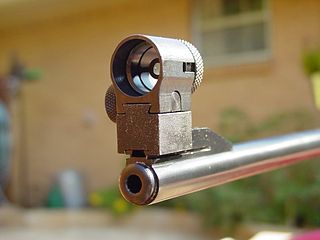
A globe sight is a front sight component used to assist the aiming of a gun/device, usually those intended to launch projectiles, such as firearms, airguns, and crossbows. It is found in particular as a front sight element on rifles.
The Walther LGR air rifle was developed by the German arms manufacturer Carl Walther GmbH Sportwaffen as a high end match rifle for 10 metre air rifle competition shooting. The LGR was the first match air rifle that employed the then futuristic single-stroke pneumatic method as power source. This use of pre compressed air introduced the advantages of recoilless and vibration free shooting in combination with a well-made air rifle into the sport. It took other manufacturers a decade before they also introduced single-stroke pneumatic match air rifles.

The PSO-1 is a 4×24 telescopic sight manufactured in Russia by the Novosibirsk instrument-making factory and issued with the Russian military Dragunov sniper rifle. It was introduced on 3 July 1963 together with the Dragunov sniper rifle.
The SIG Sauer 200 STR, also known as the SIG Sauer 200 STR Match, is a bolt-action rifle mostly used as a target/competition rifle for national competitions by Norwegian, Swedish and Danish sport shooters. It is a variant of the Sauer 200 TR or SIG Sauer 200 TR Match rifle that features thicker 19 mm (0.75 in) diameter barrels. The 200 STR is produced by J. P. Sauer & Sohn GmbH in Germany.

A red dot sight is a common classification for a non-magnifying reflector sight that provides an illuminated red dot to the user as a point of aim. A standard design uses a red light-emitting diode (LED) at the focus of collimating optics, which generates a dot-style illuminated reticle that stays in alignment with the firearm the sight is attached to, regardless of eye position.
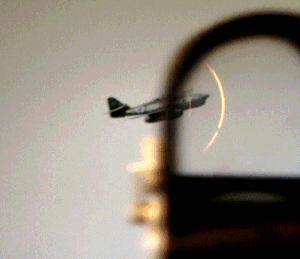
A reflector sight or reflex sight is an optical sight that allows the user to look through a partially reflecting glass element and see an illuminated projection of an aiming point or some other image superimposed on the field of view. These sights work on the simple optical principle that anything at the focus of a lens or curved mirror will appear to be sitting in front of the viewer at infinity. Reflector sights employ some form of "reflector" to allow the viewer to see the infinity image and the field of view at the same time, either by bouncing the image created by lens off a slanted glass plate, or by using a mostly clear curved glass reflector that images the reticle while the viewer looks through the reflector. Since the reticle is at infinity, it stays in alignment with the device to which the sight is attached regardless of the viewer's eye position, removing most of the parallax and other sighting errors found in simple sighting devices.
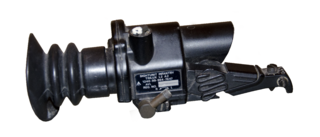
The SUIT sight is a 4× prism sight with tritium-powered illumination, utilised at dusk or dawn. The full name is the L2A2 Sight Unit Infantry Trilux. The sight is not designed as a sniper sight, but as a standard issue infantry sight to improve the infantryman's night fighting capability and to assist target identification at long range in daylight and in poor light conditions.
The Colt Canada C19 is a licence-built, Finnish-designed Tikka T3 CTR bolt-action rifle modified for the Canadian Rangers. The C19 replaced the longer and heavier Lee-Enfield No. 4 Mk.1 rifles which entered service in 1947.

Shooting glasses are specialized corrective glasses for use in shooting and are used almost exclusively in sport shooting competitions. Like other glasses, they are worn in front of the eyes to compensate for the shooter's ametropia with optical lenses.
